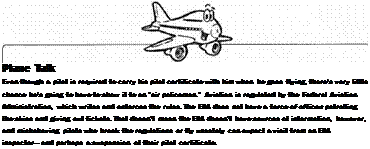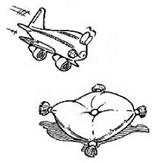From Takeoff to Landing
|
|
 |
When a pilot puts together all the skills of maneuvering an airplane, understands how to navigate it from one airport to another, and has a sturdy understanding of the forces that affect the airplane in flight, he’s almost ready to start a cross-country (airport-to-airport) flight.
Let’s take a look at what happens in a typical flight, from the preflight checks to the landing.
Preflight: Keeping it Safe
There are a few things the pilot has to do even before the flight begins. First, he’ll have to have planned the cross-country flight based on the weather conditions and the weight limitations of the plane (see Chapter 14, “Navigation: Getting from Here to There Without Street Signs,” for details).
Second, pilots have to make sure that they are healthy and prepared to fly. Physical conditions that are only annoyances on the ground can be magnified by the effects of
 |
altitude. Even some simple over-the-counter cold or allergy medications can slow down reactions and render a person unfit to fly until the medication fully wears off. Many pilots find it hard to admit to themselves that they are in no physical condition to fly, or that they lack the training and experience to make the flight safely. As we’ll discuss in Chapter 19, “Emergencies in the Air,” a better grasp of pilots’ limitations would prevent a vast number of aviation accidents.
Third, the pilot must make sure the airplane’s paperwork is in proper order. A plane can’t legally fly without its paperwork on board. A student pilot flying solo is required to take along his logbook containing a short entry by his flight instructor giving permission for the flight. And of course, just as a car driver has to have a driver’s license with him, all pilots must also carry their pilot certificate. For student pilot, the student pilot certificate and medical certificate are one and the same.
 |
A last item of paperwork is to check the maintenance condition of the airplane. Depending on the flight school or fixed-base operator, the maintenance logs will be stored in different places, but they should always be checked before starting out to ensure that the airplane has been inspected within the last 100 hours of flight time and that any malfunctions noted by other pilots have been repaired.












